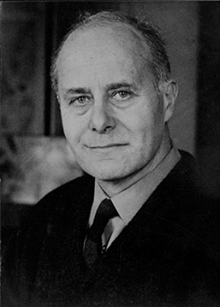Gordon Rattray Taylor
Gordon Rattray Taylor (11 January 1911 – 7 December 1981) was a popular British author and journalist. He is most famous for his 1968 book The Biological Time Bomb, which heralded the rise of biotechnology and for his 1983 book The Great Evolution Mystery.
Gordon Rattray Taylor | |
|---|---|
 | |
| Born | 11 January 1911 |
| Died | 7 December 1981 (aged 70) |
| Occupation | Journalist, writer |
Biography
Gordon Rattray Taylor was born in Eastbourne on 11 January 1911, and educated at Radley College public school, before studying natural sciences at Trinity College, Cambridge. In 1933 he entered journalism. During the war he worked in the Psychological Warfare division of SHAEF. In 1958 he joined the BBC where he wrote and devised science television programs such as Eye on Research. In 1966 he became a full-time author. He served as a member of the Society for Psychical Research, London (1976–81).[1]
Writing
In The Biological Time Bomb Taylor heralded the advent of artificial insemination, organ transplants, as well as research into memory and controlling moods.[2]
Evolution
Taylor wrote a book on evolution called The Great Evolution Mystery first released in 1983 with a second edition in 1984. Taylor criticized neo-Darwinism, and said that the origin of species and the mechanisms for evolution are still deep mysteries that have not been solved. Taylor supported Lamarck over Darwin.[3]
Taylor discussed the possibility of an inherent self-stabilization of the genome as an important selective factor in evolution. He was supportive of the idea of Lancelot Law Whyte, the evolutionary ideas highlighted in Whyte’s book Internal factors of evolution in which no mutation is due entirely to chance: only those that meet the internal demands of the genome can be utilized in evolutionary processes.[4]
Taylor discussed his own evolutionary mechanism called "masking theory" which is the notion that blueprints for building phenotypes can be hidden for millions of years before suddenly being expressed by the species.[5]
Zoologist Mark Ridley negatively reviewed the book concluding that Taylor had a "complete lack of biological imagination". Ridley states that Taylor appears to have failed to have familiarised himself with Darwinian thinking before criticising it, and particularly that Taylor has made the "familiar and elementary" mistake of conflating natural selection with chance. Ridley states that Taylor's alternative to Darwinian evolution is described "only in general outline", involving "Lamarckism and other inarticulated internal factors".[6]
In contrast to Ridley; the anthropologist H. James Birx in BioScience positively reviewed the book. According to Birx:
Taylor boldly claims that the living world of increasing complexity is not one of mere chance and material determinism, or the result of a divine plan and vital force. Instead, he strongly suggests that life is ordered through some internal genetic mechanism... Within this open framework, the author believes that neo-Darwinism is only a subsection of a more comprehensive and sophisticated explanation for biological evolution still to be formulated.
Birx concluded that The Great Evolution Mystery is a "stimulating book and raises important questions and encourages future scientific inquiry."[7]
Philosopher Michael Ruse gave the book a mixed review, stating that although he didn't find Taylor's arguments convincing, he had collected a lot of information and utilized very good illustrations.[8]
Books
- Sex in History (1954)
- Economics for the Exasperated (1948)
- Conditions of Happiness
- Are Workers Human?
- The Angel Makers
- The Science of Life: A Pictorial History of Biology (1967)
- The Biological Time Bomb (1968) ISBN 0-500-01046-3
- Rethink: A Paraprimitive Solution (1972) ISBN 0-436-51635-7
- Rethink: Radical Proposals to Save a Disintegrating World (1974) ISBN 0-14-021831-9
- The Doomsday Book: Can the World Survive? (1st ed. : 1970 / ed.1972) ISBN 0-586-03604-0, ISBN 0-500-01067-6
- How to Avoid the Future (1978) ISBN 0-436-51637-3
- Salute to British Genius (1978) ISBN 0-436-51637-3
- The Natural History of the Mind (1981) ISBN 0-586-08386-3
- The Great Evolution Mystery (1983)
See also
References
- Hasler, P. W. (1982). Obituary: Gordon Rattray Taylor. Journal of the Society for Psychical Research 51: 405.
- Kilpatrick, James J. (6 February 1971). "Miracles Of Science .Far-out Commission Needed". The Evening Independent. Retrieved 5 June 2011.
- Gordon Rattray Taylor, The Great Evolution Mystery, Publisher Abacus, 1984 ISBN 0-349-12917-7
- John Templeton, Robert L. Herrmann, The God who would be known: revelations of the divine in contemporary science, 1998, p. 65 - 66
- Taylor, 1984 pp. 180 - 181
- Ridley, Mark (28 April 1983). "A lack of biological imagination". New Scientist. Retrieved 13 June 2011.
- Birx, James H. (1984). Neo-Darwinism and Neo-Social Darwinism. The Great Evolution Mystery by Gordon Rattray Taylor; Conscientious Evolution by Herbert F. Mataré. BioScience 34: 196-197.
- Ruse, Michael. (1984). Great Evolution Mystery by Gordon Rattray Taylor. The Quarterly Review of Biology 59: 56.